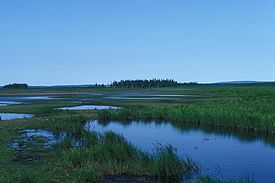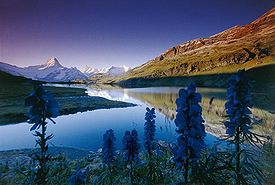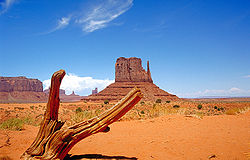- Wilderness
-
For other uses, see Wilderness (disambiguation).
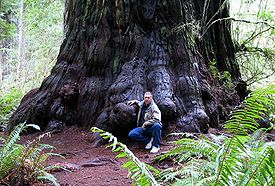 This is a redwood tree in northern California redwood forest, where many redwood trees are managed for preservation and longevity.
This is a redwood tree in northern California redwood forest, where many redwood trees are managed for preservation and longevity.
Wilderness or wildland is a natural environment on Earth that has not been significantly modified by human activity. It may also be defined as: "The most intact, undisturbed wild natural areas left on our planet—those last truly wild places that humans do not control and have not developed with roads, pipelines or other industrial infrastructure."[1] Wilderness areas can be found in preserves, estates, farms, conservation preserves, ranches, National Forests, National Parks and even in urban areas along rivers, gulches or otherwise undeveloped areas. These areas are considered important for the survival of certain species, biodiversity, ecological studies, conservation, solitude, and recreation. Wilderness is deeply valued for cultural, spiritual, moral, and aesthetic reasons. Some nature writers believe wilderness areas are vital for the human spirit and creativity.[2] They may also preserve historic genetic traits and that they provide habitat for wild flora and fauna that may be difficult to recreate in zoos, arboretums or laboratories.
The word wilderness derives from the notion of "wildness"—in other words, that which is not controllable by humans. The word's etymology is from the Old English wildeornes, which in turn derives from wildeor meaning wild beast (wild + deor = beast, deer) (The Collins English Dictionary, 2000). From this point of view, it is the wildness of a place that makes it a wilderness. The mere presence or activity of people does not disqualify an area from being "wilderness." Many ecosystems that are, or have been, inhabited or influenced by activities of people may still be considered "wild." This way of looking at wilderness includes areas within which natural processes operate without human interference.
The WILD Foundation states that wilderness areas have two dimensions: they must be biologically intact and legally protected.[3][4] The World Conservation Union (IUCN) classifies wilderness at two levels, Ia (Strict Nature Reserves) and Ib (Wilderness Areas). Most scientists and conservationists[by whom?] agree that no place on earth is completely untouched by humanity, either due to past occupation by indigenous people, or through global processes such as climate change. Activities on the margins of specific wilderness areas, such as fire suppression and the interruption of animal migration also affect the interior of wildernesses.[5]
Especially in wealthier, industrialized nations, it has a specific legal meaning as well: as land where development is prohibited by law. Many nations have designated wilderness, including Australia, Canada, New Zealand, South Africa and the United States. Many new parks are currently being planned and legally passed by various Parliaments and Legislatures at the urging of dedicated individuals around the globe who believe that "in the end, dedicated, inspired people empowered by effective legislation will ensure that the spirit and services of wilderness will thrive and permeate our society, preserving a world that we are proud to hand over to those who come after us."[6]
Contents
History
Looked at through the lens of the visual arts, nature and wildness have been important subjects in various epochs of world history. An early tradition of landscape art occurred in the Tang Dynasty (618-907). The tradition of representing nature as it is became one of the aims of Chinese painting and was a significant influence in Asian art. Artists in the tradition of Shan shui (lit. mountain-water-picture), learned to depict mountains and rivers "from the perspective of nature as a whole and on the basis of their understanding of the laws of nature… as if seen through the eyes of a bird.” In the 13th century, Shih Erh Chi recommended avoiding painting "scenes lacking any places made inaccessible by nature."[7]
The idea of wilderness having intrinsic value emerged in the Western world in the 19th century. British artists John Constable and JMW Turner turned their attention to capturing the beauty of the natural world in their paintings. Prior to that, paintings had been primarily of religious scenes or of human beings. William Wordsworth’s poetry described the wonder of the natural world, which had formerly been viewed as a threatening place. Increasingly the valuing of nature became an aspect of Western culture.[8]
Over the course of the 19th century wilderness became to be viewed not as a place to fear but a place to enjoy and protect, hence came the conservation movement in the latter half of the 19th century. Rivers were rafted and mountains were climbed solely for the sake of recreation, not to determine their geographical contexture. This profound shift in wilderness thought reached a pinnacle in the US with the passage of the Wilderness Act of 1964, which allowed for parts of U.S. National Forests to be designated as "wilderness preserves". Similar acts, such as the 1975 Eastern Wilderness Act, followed.
The 21st century has seen another slight shift in wilderness thought and theory. It is now understood that simply drawing lines around a piece of land and declaring it a wilderness does not necessarily make it a wilderness. All landscapes are intricately connected and what happens outside a wilderness certainly affects what happens inside it. For example, air pollution from Los Angeles and the California Central Valley affects Kern Canyon and Sequoia National Park. The national park has miles of "wilderness" but the air is filled with pollution from the valley. This gives rise to the paradox of what a wilderness really is; a key issue in 21st century wilderness thought.
Preservation
For most of human history, the greater part of the Earth's terrain was wilderness, and human attention was concentrated in settled areas. The first known laws to protect parts of nature date back to the Babylonian Empire and Chinese Empire. Ashoka, the Great Mauryan King, defined the first laws in the world to protect flora and fauna in Edicts of Ashoka around 3rd Century B.C. In the Middle Ages, the Kings of England initiated one of the world’s first conscious efforts to protect natural areas. They were motivated by a desire to be able to hunt wild animals in private hunting preserves rather than a desire to protect wilderness. Nevertheless, in order to have animals to hunt they would have to protect wildlife from subsistence hunting and the land from villagers gathering firewood.[8] Similar measures were introduced in other European countries.
Early in the 19th century, Wordsworth and other romanticists in the U.K., concerned about "the excesses of industrialization and urbanization," called for a return to natural environments. This movement achieved some gains in protecting sensitive ecosystems, but a more successful form of environmentalism emerged in Germany by the mid-19th century. “Scientific Conservation,” as it was called, advocated "the efficient utilization of natural resources through the application of science and technology." Concepts of forest management based on the German approach were applied in other parts of the world, but with varying degrees of success.[9]
By the later 19th century it had become clear that in many countries wild areas had either disappeared or were in danger of disappearing. This realisation gave rise to the conservation movement in the USA, partly through the efforts of writers and activists such as John Burroughs and John Muir, and politicians such as U.S. President Teddy Roosevelt.
National parks
The creation of National Parks, beginning in the 19th century, preserved some especially attractive and notable areas, but the pursuits of commerce, lifestyle, and recreation combined with increases in human population have continued to result in human modification of relatively untouched areas. Such human activity often negatively impacts native flora and fauna. As such, to better protect critical habitats and preserve low-impact recreational opportunities, legal concepts of "wilderness" were established in many countries, beginning with the United States (see below).
The first National Park was Yellowstone, signed into law by U.S. President Ulysses S. Grant on March 1, 1872.[10] The creation of this and other parks showed a growing appreciation of wild nature, but also an economic reality. The railways wanted to entice people to travel west. The world's second national park, the Royal National Park, was established in 1879.[11] Just 25 km to the south of Sydney, Australia.
This U.S. concept of national parks soon caught on in Canada, which created Banff National Park in the 1880s, at the same time as the transcontinental Canadian Pacific Railway was being built. Parks such as Banff and Yellowstone gained favor as the railroads advertised travel to "the great wild spaces" of North America. When outdoorsman Teddy Roosevelt became president of the United States, he began to enlarge the U.S. National Parks system, and established the National Forest system.[8]
By the 1920s, travel across North America by train to experience the "wilderness" (often viewing it only through windows) had become wildly popular. This led to the commercialization of some of Canada's National Parks with the building of great hotels such as the Banff Springs Hotel and Chateau Lake Louise.
Conservation vs. preservation
Two opposing factions had emerged within the environmental movement by the early 20th century: the conservationists and the preservationists. The conservationists (such as Gifford Pinchot) focused on the proper use of nature, whereas the preservationists sought the protection of nature from use.[9] Put another way, conservation sought to regulate human use while preservation sought to eliminate human impact altogether.
The idea of protecting nature for nature's sake began to gain more recognition in the 1930s with American writers like Aldo Leopold, calling for a "land ethic" and urging wilderness protection. It had become increasingly clear that wild spaces were disappearing rapidly and that decisive action was needed to save them.
Global conservation became an issue at the time of the dissolution of the British Empire in Africa in the late 1940s. The British established great wildlife preserves there. As before, this interest in conservation had an economic motive: in this case, big game hunting. Nevertheless, this led to growing recognition in the 1950s and the early 1960s of the need to protect large spaces for wildlife conservation worldwide. The World Wildlife Fund (WWF), founded in 1961, grew to be one of the largest conservation organizations in the world.[8]
Preservation again came to the fore in the 1960s with the publication of Rachel Carson’s Silent Spring in 1962, which was the genesis of the modern environmental movement. Major environmental groups such as the Sierra Club shifted from protesting to working with politicians to influence environmental policy.[9]
Nevertheless, initiatives for wilderness conservation continue to increase. There are a growing number of projects to protect tropical rainforests through conservation initiatives. There are also large-scale projects to conserve wilderness regions, such as Canada's Boreal Forest Conservation Framework. The Framework calls for conservation of fifty percent of the 6,000,000 square kilometres of boreal forest in Canada's north.[12] In addition to the World Wildlife Fund, organizations such as The WILD Foundation, The Nature Conservancy, Conservation International, The Wilderness Society (United States) and many others are active in such conservation efforts.
Designations
New Zealand
There are seven wilderness areas in New Zealand as defined by the National Parks Act 1980 and the Conservation Act 1987 that fall well within the IUCN definition. Wilderness areas cannot have any human intervention and can only have indigenous species re-introduced into the area if it is compatible with conservation management strategies.
In New Zealand wilderness areas are remote blocks of land that have high natural character. The Conservation Act 1987 prevents any access by vehicles and livestock, the construction of tracks and buildings, and all indigenous natural resources are protected.[13] They are generally over 40,000 ha in size.[14]
United States
- Main article: National Wilderness Preservation System
 Latir Peak Wilderness, taken from milepost 394 along US-285, ten miles north of Tres Piedras and 14 miles south of the New Mexico and Colorado border.
Latir Peak Wilderness, taken from milepost 394 along US-285, ten miles north of Tres Piedras and 14 miles south of the New Mexico and Colorado border.
In the United States, a Wilderness Area is an area of federal land set aside by an act of Congress. Human activities in wilderness areas are restricted to scientific study and non-mechanized recreation; horses are permitted but mechanized vehicles and equipment, such as cars and bicycles, are not.
 The Great Swamp of New Jersey, donated for federal protection by concerned residents, was designated as the first wilderness refuge in the United States - winter scene in March, 2008
The Great Swamp of New Jersey, donated for federal protection by concerned residents, was designated as the first wilderness refuge in the United States - winter scene in March, 2008
The United States was the first country to officially designate land as "wilderness" through the Wilderness Act of 1964. Wilderness designation helps preserve the natural state of the land and protects flora and fauna by prohibiting development and providing for non-mechanized recreation only. The first wilderness refuge designation was for the Great Swamp in New Jersey. Properties in the swamp had been acquired by residents of the area who donated it to the federal government as a park for perpetual protection. Today the refuge amounts to 7,600 acres (31 km2) that are within thirty miles of Manhattan.[15]
While wilderness designations were originally granted by an Act of Congress for Federal land that retained a "primeval character", meaning that it had not suffered from human habitation or development, the Eastern Wilderness Act of 1975 extended the protection of the NWPS to areas in the eastern States that were not initially considered for inclusion in the Wilderness Act. This act allowed lands that did not meet the constraints of size, roadlessness, or human impact to be designated as wilderness areas under the belief that they could be returned to a "primeval" state through preservation.[16]
Approximately 100 million acres (400,000 km²) are designated as wilderness in the United States. This accounts for 4.71% of the total land of the country; however, 54% of wilderness is in Alaska, although recreation and development in Alaskan wilderness is often less restrictive and only 2.58% of the lower continental United States is designated as wilderness. Following the Omnibus Public Land Management Act of 2009 there are 756 separate wilderness designations in the United States ranging in size from Florida's Pelican Island at 5 acres (20,000 m2) to Alaska's Wrangell-Saint Elias at 9,078,675 acres (36,740.09 km2).
International movement
At the forefront of the international wilderness movement has been The WILD Foundation, its founder Ian Player and its network of sister and partner organizations around the globe. The pioneer World Wilderness Congress in 1977 introduced the wilderness concept as an issue of international importance, and began the process of defining the term in biological and social contexts. Today, this work is continued by many international groups who still look to the World Wilderness Congress as the international venue for wilderness and to The WILD Foundation network for wilderness tools and action. The WILD Foundation also publishes the standard references for wilderness professionals and others involved in the issues: Wilderness Management: Stewardship and Protection of Resources and Values, the International Journal of Wilderness, A Handbook on International Wilderness Law and Policy and Protecting Wild Nature on Native Lands] are the backbone of information and management tools for international wilderness issues.
The Wilderness Task Force within the World Commission on Protected Areas (WTF/WCPA) of the International Union for the Conservation of Nature (IUCN) plays a critical role in defining legal and management guidelines for wilderness at the international level and is also a clearing-house for information on wilderness issues. The IUCN Protected Areas Classification System defines wilderness as “A large area of unmodified or slightly modified land, and/or sea retaining its natural character and influence, without permanent or significant habitation, which is protected and managed so as to preserve its natural condition (Category 1b).” The WILD Foundation founded the WTF/WCPA in 2002 and remains co-chair.
Extent
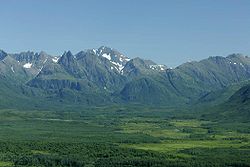 The Ahklun Mountains and the Togiak Wilderness within the Togiak National Wildlife Refuge in the U.S. state of Alaska
The Ahklun Mountains and the Togiak Wilderness within the Togiak National Wildlife Refuge in the U.S. state of Alaska
According to a major study, Wilderness: Earth's Last Wild Places, carried out by Conservation International, 46% of the world's land mass is wilderness. For purposes of this report, "wilderness" was defined as an area that "has 70% or more of its original vegetation intact, covers at least 10,000 square kilometers (3,900 sq mi) and must have fewer than five people per square kilometer."[17] However, an IUCN/UNEP report published in 2003, found that only 10.9% of the world's land mass is currently a Category 1 Protected Area, that is, either a strict nature reserve (5.5%) or protected wilderness (5.4%).[18] Such areas remain relatively untouched by humans. Of course, there are large tracts of lands in National Parks and other protected areas that would also qualify as wilderness. However, many protected areas have some degree of human modification or activity, so a definitive estimate of true wilderness is difficult.
The Wildlife Conservation Society generated a human footprint using a number of indicators, the absence of which indicate wildness: human population density, human access via roads and rivers, human infrastructure for agriculture and settlements and the presence of industrial power (lights visible from space). The society estimates that 26% of the Earth's land mass falls into the category of "Last of the wild." The wildest regions of the world include the tundra, the taiga, the Amazonian rain forest, the Tibetan Plateau, the Australian outback and deserts such as the Sahara, and the Gobi.[19]
It should be noted that the percentage of land area designated "wilderness" does not reflect "quality" of remaining wilderness, part of which is barren areas with low biodiversity. Of the last natural wilderness areas, the taiga—which is mostly wilderness—represents 11% of the total land mass in the Northern Hemisphere.[20] Tropical rainforest represent a further 7% of the world's land base.[21] Estimates of the Earth's remaining wilderness underscore the rate at which these lands are being developed, with dramatic declines in biodiversity as a consequence.
Criticism of the Concept of Wilderness
The American concept of wilderness has been criticized by some nature writers. For example, William Cronon writes that what he calls a wilderness ethic or cult may "teach us to be dismissive or even contemptuous of such humble places and experiences", and that "wilderness tends to privilege some parts of nature at the expense of others", using as an example "the mighty canyon more inspiring than the humble marsh."[22] This is most clearly visible with the fact that nearly all U.S. National Parks preserve spectacular canyons and mountains, and it was not until the 1940s that a swamp became a national park—the Everglades. In the mid-20th century national parks started to protect biodiversity, not simply attractive scenery.
Cronon also believes the passion to save wilderness "poses a serious threat to responsible environmentalism" and writes that it allows people to "give ourselves permission to evade responsibility for the lives we actually lead....to the extent that we live in an urban-industrial civilization" but at the same time pretend to ourselves that our real home is in the wilderness,"[22]
Michael Pollan has argued that the wilderness ethic leads people to dismiss areas whose wildness is less than absolute. In his book Second Nature, Pollan writes that "once a landscape is no longer 'virgin' it is typically written off as fallen, lost to nature, irredeemable."[23] Another challenge to the conventional notion of wilderness comes from Robert Winkler in his book, Going Wild: Adventures with Birds in the Suburban Wilderness. “On walks in the unpeopled parts of the suburbs," Winkler writes, "I’ve witnessed the same wild creatures, struggles for survival, and natural beauty that we associate with true wilderness.”[24]
See also
- Adventure travel
- Biomass
- Biomass (ecology)
- Bioproduct
- Camping
- Conservation movement
- Deforestation
- Ecological footprint
- Environmental education
- Forest
- Geology
- Global warming
- Hiking
- Intact forest landscape
- John Muir Lifetime Achievement Award
- Land use
- Last of the Wild
- Leave no trace
- List of U.S. Wilderness Areas
- List of conservationists
- National Outdoor Leadership School
- National Wilderness Preservation System
- National Wildlife Magazine
- Natural landscape
- Old Growth forest
- Outdoor education
- Permaforestry
- Planetary habitability
- Protected Areas
- Wild fisheries
- Wildcrafting
- Wilderness Act
- Wilderness Area (Protected Area Management Category)
- World Wilderness Congress
References
 This spiny forest at Ifaty, Madagascar features various Adansonia (baobab) species, Alluaudia procera (Madagascar ocotillo) and other vegetation.
This spiny forest at Ifaty, Madagascar features various Adansonia (baobab) species, Alluaudia procera (Madagascar ocotillo) and other vegetation.
- ^ "What is a Wilderness Area". The WILD Foundation. http://www.wild.org/main/about/what-is-a-wilderness-area/. Retrieved 2009-02-20.
- ^ No Man's Garden by Daniel B. Botkin p155-157
- ^ Wilderness Areas are Biologically Intact
- ^ Wilderness as a Protected Area Classification
- ^ "WHAT IS WILDLAND? - a review". http://www.wildland-network.org.uk/wn_what_wildland.htm. Retrieved 2009-07-14.
- ^ Vance G. Martin and Ian C. Player, Forward, A Handbook on International Wilderness Law and Policy
- ^ Chinese brush painting Asia-art.net Retrieved on: May 20, 2006.
- ^ a b c d History of Conservation BC Spaces for Nature. Retrieved: May 20, 2006.
- ^ a b c Akamani, K. (nd). "The Wilderness Idea: A Critical Review." A Better Earth.org. Retrieved: June 1, 2006
- ^ Mangan, E. Yellowstone, the First National Park Library of Congress, Mapping the National Parks. Retrieved on: 2010-08-12.
- ^ New South Wales National Parks & Wildlife Service, "Parks & Reserves: Royal National Park". Accessed 21 January 2007.
- ^ Canadian Boreal Initiative Boreal Forest Conservation Framework. www.borealcanada.ca Retrieved on: December 1, 2007.
- ^ New Zealand Government (1987). "Conservation Act 1987 Part 4, Section 20". New Zealand Government. http://www.legislation.govt.nz/act/public/1987/0065/latest/DLM104684.html#DLM104684. Retrieved 2008-10-02.
- ^ Malloy, Les. "Specially protected areas". Te Ara - the Encyclopedia of New Zealand. http://www.teara.govt.nz/TheBush/Conservation/ProtectedAreas/5/en. Retrieved 2008-10-02.
- ^ U.S. Fish and Wildlife Service. Great Swamp National Wildlife Refuge. Retrieved on: June 7, 2008.
- ^ "The Wilderness Act of 1964". Western North Carolina's Mountain Treasures. Retrieved on June 16, 2010.
- ^ Conservation International (2002) Global Analysis Finds Nearly Half The Earth Is Still Wilderness. Retrieved on July 28, 2007.
- ^ Chape, S., S. Blyth, L. Fish, P. Fox and M. Spalding (compilers) (2003). 2003 United Nations List of Protected Areas. IUCN, Gland, Switzerland and Cambridge, UK and UNEP-WCMC, Cambridge, UK. PDF
- ^ Wildlife Conservation Society. 2005. State of the Wild 2006: A Global Portrait of Wildlife, Wildlands and Oceans. Washington, D.C. Island Press. pp. 16 &17.
- ^ University of Manitoba Taiga Biological Station. 2004. Frequently answered questions. Retrieved: 2006-07-04.
- ^ Rainforest Foundation US. 2006. Commonly asked questions. Retrieved: 2006-07-04.
- ^ a b The Trouble with Wilderness University of Wisconsin-Madison. Retrieved: January 28, 2007.
- ^ Pollan, Michael (2003). Second Nature: A Gardener's Education, p. 188. Grove Press. ISBN 978-0802140111.
- ^ Winkler, Robert. (2003). Going Wild: Adventures with Birds in the Suburban Wilderness. National Geographic ISBN 978-0792261681.
Further Reading
- Bryson, B. (1998). A Walk in the Woods. ISBN 0-7679-0251-3
- Gutkind, L (Ed). (2002). On Nature: Great Writers on the Great Outdoors. ISBN 1-58542-173-1
External links
- Wilderness Information Network
- Wilderness Articles, Survival Techniques, Edible Plants
- CFACT - Report spreads good news about wilderness areas
- Community of Outdoor Enthusiasts Provides Real Life Experiences and Educational Articles
- Aldo Leopold Wilderness Research Institute
- Wilderness Task Force/World Commission on Protect Areas
- Campaign for America's Wilderness
Definitions
- Detailed maps of United States wilderness designations
- What is Wilderness? - Definition & discussion of wilderness as a human construction
- Wilderness and the American Mind - by Roderick Nash
- The Meaning of Wilderness - by Sandy Schuman
- The Trouble with Wilderness; or, Getting Back to the Wrong Nature by William Cronon.
The Earth Continents Oceans Earth Natural environment Related articles Elements of nature Universe Earth Earth science · Future of the Earth · Geological history of Earth · Geology · History of the Earth · Plate tectonics · Structure of the EarthWeather Environment Life Biology · Eukaryota (Plants/Flora, Animals/Fauna, Fungi, Protista) · Evolutionary history of life · Hierarchy of life · Life on Earth · Origin of life · Prokaryotes (Archaea, Bacteria) · VirusesCategory · Portal Categories:
Wikimedia Foundation. 2010.



